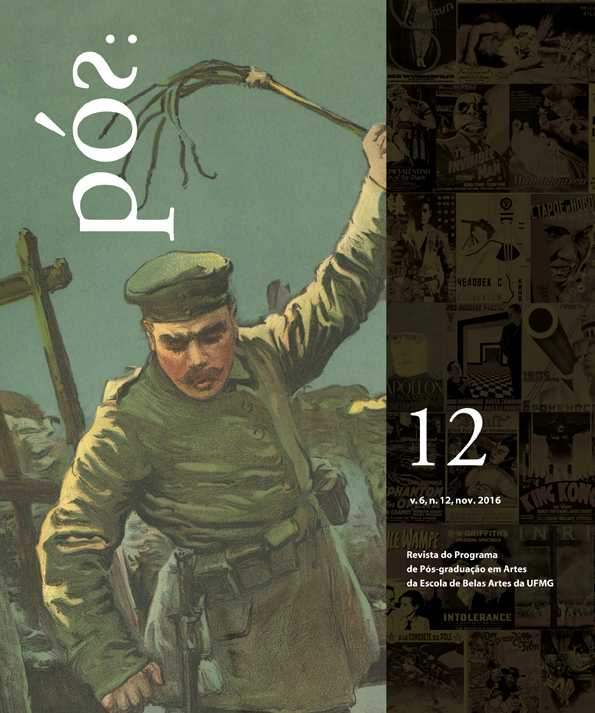CONSIDERAÇÕES SOBRE A MOSTRA THE STATIONS OF THE CROSS
LEMA SABACHTANI, DE BARNETT NEWMAN
Keywords:
Barnett Newman, Pathosfomeln, Poetic processAbstract
The article interwaves discourses on Barnett Newman’s exposition The Stations of the Cross. Lema sabachtani (1966). The working hypothesis is that the poetic gesture had been closely displaced to the artwork formation process with the concept of Pathosformeln, despite engaging with abstraction, allowing to put this reception by art criticism at the time then in another theoretical perspective.
References
ALLOWAY, Stations of the Cross. Lema Sabachtani. Catálogo, The Guggenheim R. Solomon Museum, 1966.
BESANÇON, A. Imagem proibida. Rio de Janeiro: Bertrand Brasil, 1997.
BOIS, Y.-A. Pintura como modelo. São Paulo: Martins Fontes, 2009.
DIDI-HUBERMAN, G. L´Image Survivante. Paris: Minuit, 2002.
DIDI-HUBERMAN, G. L’Image ouverte. Paris: Gallimard, 2007.
EFAL, A. Warburg’s “Pathos Formula”. In: Assaph-Studies in Art History, n. 5, 2001. Disponível: http://www5.tau.ac.il/arts/departments/images/stories/journals/arthistory/Assaph5/13adiefal.pdf. Acesso: 15/03/2010.
GODFREY, M. Barnett Newman’s ‘Stations of the Cross’ and the Memory of the Holocaust. In: HO, M. (org.) Reconsidering Barnett Newman. Philadelphia: The Philadelphia Museum of Art. 2002, p. 46-66.
GOMBRICH, E. Aby Warburg: An intellectual biography. London: The Warburg Institute, 1970.
HESS, T. Barnett Newman. New York: Walker, 1971.
KANT, I. Crítica da Faculdade do Juízo. São Paulo: Forense, 2ª ed., 2002.
LEVY-BRUHL, L. A mentalidade primitiva. São Paulo: Paulus, 2008.
LYOTARD, J.-F. Barnett Newman – O instante. In: Revista Gávea, Rio de. Janeiro: PUC-RIO, n. 4, jan, 1987, p. 83-94.
_________. O pós-moderno explicado às crianças. 2ª ed. Lisboa: Dom Quixote, 1993.
NEWMAN, B. Statement. In: The Stations of the Cross. Catálogo. New York: The Guggenheim R. Solomon Museum, 1966, p. 9.
NEWMAN, B. Barnett Newman: selected writings and interviews. Los Angeles: University of California Press, 1990.
PANOFSKY, E. Significado nas Artes Visuais. São Paulo: Perspectiva, 1979.
PANOFSKY, E. Estudos de Iconologia. Lisboa: Estampa, 1986.
PAYOT, G. Unimente – Barnett Newman: a arte abstrata e o significado. In: HUCHET, S. Fragmentos de uma teoria da arte. São Paulo: EDUSP, 2012, p. 263-287.
PUGLIESE, V. Os Sudários de Bené Fonteles, O Chemin de la Croix de Henri Matisse e as Stations of the Cross de Barnett Newman: pathos e anacronismo na Historiografia da Arte. 2013. Tese (Doutorado) – Departamento de Artes Visuais, Instituto de Artes, Universidade de Brasília, 2013.
REISE, B. The Stance of Barnett Newman. In: Studio International, 179, no. 919, February 1970, p. 49-63.
ROSENBERG, H. Barnett Newman. New York: Abrams, 1978.
SHIFF, R. To Create Oneself. In: SHIFF, R (Org.). Barnett Newman: A Catalogue Raisonné. New York: The B. Newman Foundation / Yale University Press, 2004, p. 2-115.
TEMKIN, A. Barnett Newman on Exhibition. In: TEMKIN, A. (Ed.) Barnett Newman. Philadelphia: Philadelphia Museum of Art / Yale University Press, 2002, p. 18-75.
TEMKIN, A.; PENN, S.; HO, M. Catalogue. In: TEMKIN, A. (Ed.) Barnett Newman. Philadelphia: Philadelphia Museum of Art / Yale University Press, 2002, p. 112-315.
WARBURG, A. Atlas Mnemosyne. Madrid: Akal Ediciones, 2010.
WARBURG, A. The Renewal of Pagan Antiquity. Los Angeles: Getty Fondation, 1999.
Downloads
Published
Issue
Section
License
Authors who publish in this journal agree to the following terms:
- Authors retain copyright and grant the journal the right of first publication, with the work simultaneously licensed under the a Creative Commons Attribution-NonCommercial 4.0 International License that permits sharing of the work with acknowledgement of authorship and initial publication in this journal;
- Authors are permitted to enter into additional contracts separately, for non-exclusive distribution of the version of the work published in this journal (e.g., the Creative Commons Attribution License).
- Authors are permitted and encouraged to publish and distribute their work online (e.g., in institutional repositories or on their home page) at any point before or during the editorial process, as this may generate productive changes as well as increase the impact and citation of the published work.
- It is the responsibility of the authors to obtain written permission to use in their articles materials protected by copyright law. Revista PÓS is not responsible for copyright breaches made by its contributors.












